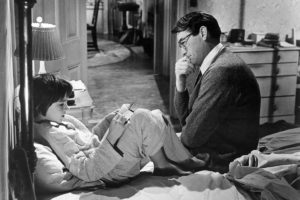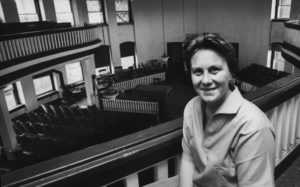
The book’s original cover (source: npr.org)
I’ve had a long relationship with To Kill A Mockingbird. I first came across it when I was maybe 10, when I watched the film adaptation. My parents introduced me to a lot of incredible movies when I was that sort of age – another notable screening being Rear Window (!) – but I don’t think I really understood anything about them. Consequently, I also don’t really have any recollection about my first brush with Harper Lee’s novel, other than I think I kind of appreciated it as far as my brain at that stage had the capability to allow, and that I thought Scout was cool, even though she had a funny name.
Then, when I was 12 and halfway through Year 8, I had to read the novel for English class – or rather, I chose it from a list of novels that we were supposed to analyse, podcast-style, as our token group assignment for the semester. I’d decided, upon my impending teenagehood, that it was time that I become better read, in order to signify just how incredibly Grown Up I was to the outside world, Mockingbird being the only classic option on the reading list for the assignment – and, I thought, the movie was pretty good, so read it I did. And… I hated it, with a vehement, irrational passion. I thought it was slow, that it contained too much information that I – in all my wisdom – deemed irrelevant to the narrative, that the characterisation was implausible, that it didn’t really seem to have a proper climax. Why do people like this, I thought – how can they read this and not see how incredibly flawed and ridiculous it is? I’ve never read a more overrated book in my life! I don’t think I even managed to finish it. But then, I found myself a few months ago plucking my parents’ copy out of their bookshelf and deciding to reappraise it. And this time… I loved it, with the same passion which highlighted my hatred a few years prior.

Mary Badham and Gregory Peck in the novel’s film adaptation, 1962 (source: The Daily Beast)
The main thing I changed my mind about was the book’s voice, something that previously had really irked me. At first, it bypassed my preteen brain entirely that the novel was narrated by an older Scout, this misunderstanding spawning much of my disdain. I had been a progenitor of some Scout-level moments of precociousness throughout my own childhood – I believe here is the point at which I should recall how I excitedly asked my Reception teacher on my first day of school what we would be required to complete for homework that night – but even I had difficulty finding the scenario of an eight-year-old child using words like ‘condescension’ in everyday conversation plausible, also unable to believe that it could’ve been narrated from adulthood due to Scout’s fairly simplistic descriptions of many of the novel’s events. But then, perhaps I was still too young myself to realise that of course Scout was narrating her memories from an older perspective, but that she tells them just as she remembers them – with the naivety and altered context with which she experienced them in childhood. There’s a kind of poetic mystery to the presentation of her memories without the proper, adult context we readers are so eager to have shown to us, her retrospective realisation of such details all to be discovered and deciphered in the subtext. It, too, was kind of beautiful how subtly Lee used this lack of context, the way the deeper messages are intertwined within what was not written, to represent one’s coming of age – how you begin to realise deeper truths and become more open-minded as you gain more years to your name, and how these changes are often so subtle that you don’t even notice them until you think back. This evokes the kind of foggy, innocent joy we often feel towards our childhoods – and yet, it also challenges our ideas about nostalgia in a spectacularly confronting manner by using this innocence to narrate a selection of the book’s most horrifying sequences. I particularly loved this about the novel, especially as a teenager who is simultaneously excited yet terrified by her impending entry into the adult world, and it’s understandable that a younger me simply could not yet appreciate this.

Author Harper Lee in 1961 (source: Getty Images)
I further adored the novel’s usage of the small town setting. Lee adeptly utilises such a backdrop both to develop a focused ensemble of intertwined, endearingly bizarre characters, and to further juxtapose the comforts of the setting’s quirky nature with the mindless prejudice and evil such concentrated isolation can breed – the contrast afforded by the latter handled in an incredibly skillful, realist manner, reflecting the often contradictory complexities of our day-to-day lives. This has long been a fiction cliche, but I now unashamedly fall for it every time, the version of me who recently reread the book having since become avidly in love with Gilmore Girls (of course, a much more positive portrait – although Mockingbird is also incredibly optimistic in tone for a lot of its narrative!) and Twin Peaks – things that a younger me just hadn’t yet had time to discover!
Of course, the book is not without its flaws, the greatest of these being its datedness. The frequent usage of then-socially acceptable racial slurs by even its “good” (for want of a less simplistic term) characters make the modern reader cringe, particularly when juxtaposed with the fact that the exploration of the effects of racism and prejudice on society is perhaps the book’s thesis statement. However, although this aspect of the book remains unacceptable by our standards, so much of its thematic content and general sentiments on the vileness of racism and those who follow it, the acceptance that everyone should feel toward their fellow human beings, still ring true in an age that will be defined in future history textbooks by its widened cultural divide, and the horrifying uprisings of bigotry and violence that have stemmed from this. The book’s sentiments were so beautiful in both their angry passion and their undying, almost heartrendingly naive optimism, and the contrasting of this with incredibly horrifying – in that such things could ever be thought of as happening at all, and in that they still continue to occur, to some degree, close to ninety years from the book’s setting – events, such as the trial’s verdict and the fate of Tom Robinson, makes for affecting, relevant reading. This appreciation of its social sentiments is something that thankfully has been a constant between both my readings.

A mockingbird, Lee’s symbol of innocence (source: Ryan Hagerty/The National Digital Library of the United States Fish and Wildlife Service)
It’s kind of funny, because in the end, I feel like one of the greatest messages I took from To Kill A Mockingbird is that of the slow, almost unnoticeable crawl that is one’s coming of age – and perhaps, my relationship with the book carries this too. Twelve year old me couldn’t appreciate the narrative because she didn’t know enough about art, about the world, she hadn’t grown up enough herself to see the potency of its craft and its message-making – and yet I am not sure I have discovered everything about it either. I feel that if I were to reread it again in a few years’ time, renewed experiences and wisdom would ensure that I would yet again take away different ideas. It’s cool how things change, right?
